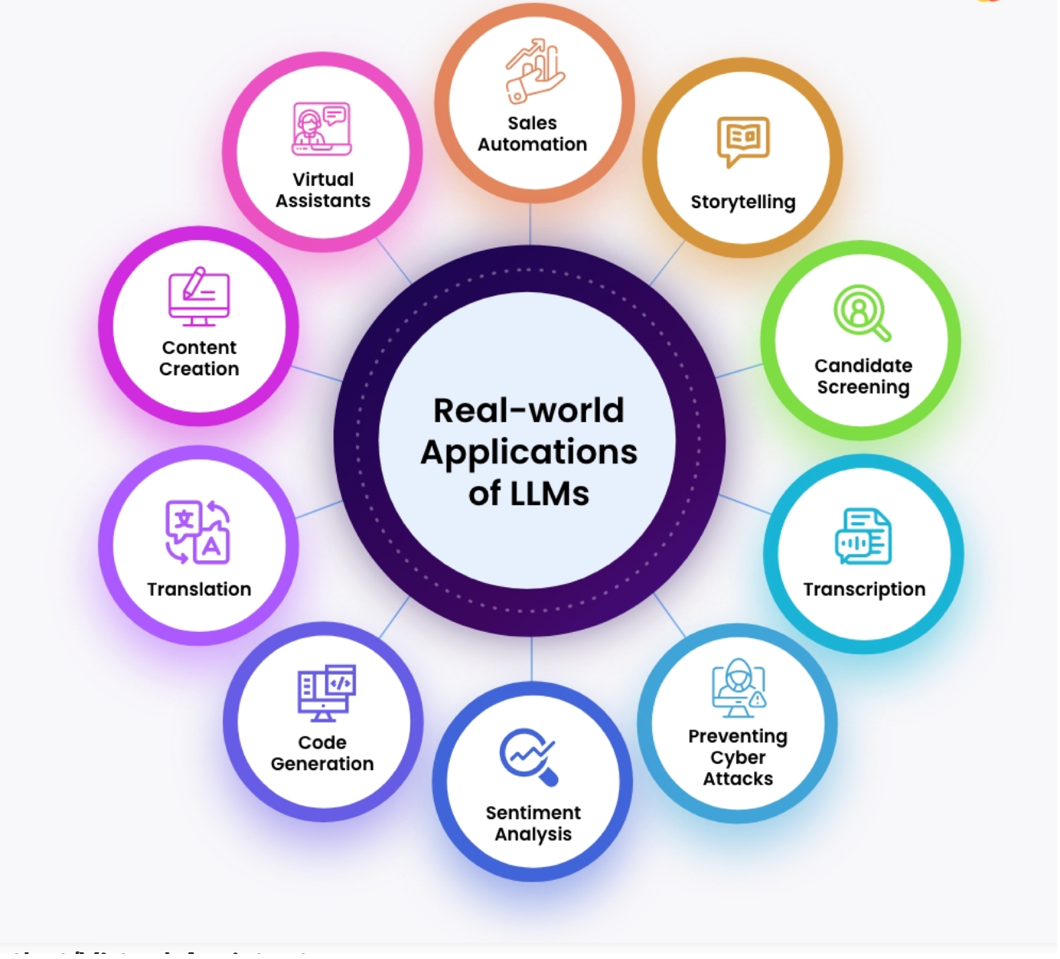By: Ananya Dixit
"With LLMs, we are witnessing the dawn of a new era, where machines become our linguistic partners, shaping thoughts into eloquent expressions."
The advent of Large Language Models (LLMs) has revolutionized the way we interact with and generate language in the digital realm. Over the past few years, LLMs have gained significant traction, thanks to ground-breaking advancements made by companies like OpenAI. These state-of-the-art models have been trained on massive datasets, enabling them to comprehend and interpret human language with remarkable accuracy and fluency.
By leveraging the power of Artificial Intelligence and Machine Learning, LLMs possess the ability to understand, analyse, and generate language that closely resembles human- written text, on an unprecedented scale. This technological breakthrough has unlocked new possibilities across various domains, including content creation, data analysis, programming code generation, and beyond. Some popular LLMs, like OpenAI’s GPT-3, employ a type of neural network called a transformer, which allows them to handle complex language tasks with remarkable proficiency.
Harnessing the capabilities of LLMs, we can now automate language-related tasks that were previously considered highly complex or time-consuming. These models have the potential to streamline processes, enhance productivity, and open up new avenues for innovation across multiple industries.

Let's look at some of the various real world of Large Language Models :
Answering Questions: The applications can seamlessly integrate the capabilities of "Search" and "Summarize" through the use of Large Language Models (LLMs). The process commences with an LLM interpreting the user's query or requirements, enabling it to identify and retrieve the most relevant data set. Subsequently, another LLM is employed to condense and summarize the retrieved data into a concise and coherent response tailored to the user's initial request.
Some real-life examples of the same include:
Legal and Financial Analysis: Large Language Models (LLMs) possess the remarkable capability to analyze and summarize extensive legal or financial documents, such as contracts or annual reports. This functionality can prove invaluable in extracting the most significant terms, ideas, and data points from these often voluminous and complex documents.
Customer Support Systems: The versatility of Large Language Models (LLMs) enables them to drive question-answering systems across diverse domains, including customer service, education, and healthcare. For instance, in customer support, a chatbot powered by LLMs can effectively comprehend and interpret customer inquiries, subsequently providing prompt and accurate responses.
Language Translation: Since LLMs are natural translators and are aware of the nuances of several languages, they can increase translation accuracy and speed. This could be beneficial for multinational corporations or individuals who need to communicate with non- native speakers of different languages.
Extraction and Expansion: Large volumes of unstructured data, such customer reviews and social media posts, can be mined for information by LLMs.
LLMs can add more paragraphs, sentences, or thoughts to existing text to make it more comprehensive. In order to expand, LLM can create additional content that is connected to the original text by using strategies like text generation and semantic similarity. This has applications in content production, marketing, and creative writing.
Search & Recommendations: LLMs can improve the quality of search results by providing the user with more relevant and accurate information.
PageRank-style methods are being replaced by LLM-based methods, which understand language much more profoundly and can find and recommend relevant results. It is important because more and more people are using long-form searches, direct questions, and conversational cues to find information.
To tailor content recommendations in recommendation systems, LLMs examine user preferences, search history, and interaction data. They can anticipate user requirements, which improves the user experience overall.
Content Generation by Writing or Editing: This is the most common and widely used application of LLMs. The main goal is to boost the productivity of knowledge workers or, in certain situations, eliminate the need for human intervention completely if the task at hand is straightforward enough. Generative technology has numerous applications, including conversational artificial intelligence and chatbots, marketing copy creation, code assistants, and the generation of high-quality content such as articles, summaries, captions, and even music.
Let's discuss some of the examples :
Content Creation: LLMs are capable of producing fresh content for blogs, social media, and other online platforms.
Storytelling: LLMs can be used to create original narratives or narratives based on a given prompt or themes.
Content Augmentation: By adding more context- or detail-rich text, LLMs can enhance existing information.
Research and Analysis: In the realm of research, LLMs can be leveraged to scour extensive literature, identifying relevant information, synthesizing key findings, and uncovering patterns or connections that may have been overlooked by human researchers. This capability enables more efficient and comprehensive literature reviews, accelerating the pace of scientific discovery and academic progress.
LLMs can also assist in the generation of research papers, reports, and other academic publications. By summarizing complex concepts and findings clearly and coherently, LLMs aid researchers in effectively communicating their work to a broader audience, fostering knowledge dissemination and collaboration.
Furthermore, since market research is crucial for developing a content strategy or introducing a new product, how and what is written about is often determined by the gathered information. LLMs and other language models can assist in obtaining and examining accurate data for competitor and market research.
Code Development: Large language models can assist programmers in writing, reviewing, and debugging code. These models can understand and generate code snippets, suggest completions, and even write entire functions based on brief descriptions. LLMs can translate code between different programming languages, making it easier for developers to work with unfamiliar syntax or migrate projects to a new language.
Virtual Assistants: Natural language processing and understanding (LLM) is the foundation of AI-powered virtual assistants. When a user issues a command or asks a query, the LLM understands the context and goal of the request. After determining the intent, the LLM produces a suitable answer. In order to give individualized responses and get better over time, modern virtual assistants also pick up on interactions. They consider user preferences, examine feedback, and adjust to each user's particular communication style.
Sentiment Analysis: Sentiment analysis is an increasingly important application of large language models (LLMs). LLMs can be fine-tuned on labelled datasets of text data to classify the underlying sentiment expressed, typically into categories like positive, negative, and neutral. This allows systems to automatically gauge the emotional tone and opinions expressed in large volumes of text, such as product reviews, social media posts, customer feedback, and more.
By leveraging the massive knowledge and language understanding capabilities of LLMs, sentiment analysis models can pick up on nuanced expressions of sentiment, going beyond just detecting obvious positive or negative language. Leading LLMs like GPT-3 have shown strong performance on sentiment analysis benchmarks. As LLMs continue to advance, sentiment analysis powered by these models will become an increasingly vital tool for understanding the opinions and emotions expressed across the vast textual data on the internet and beyond.
understanding the opinions and emotions expressed across the vast textual data on the internet and beyond.
Anomaly Detection: Statistical methods such as Z-score or machine learning algorithms such as Isolation Forests are frequently employed for anomaly detection. Long Short-Term Memory networks (LSTMs) may be used with time-series data to identify anomalies over time. Companies can proactively identify and reduce risks by using anomaly detection in a variety of fields, including fraud detection, manufacturing quality control, and market trend prediction.
Language Translation and Localization: LLMs enable your company to reach a worldwide audience by assisting in the removal of language barriers. By providing precise translation and localization services in real-time, these models enable the ubiquitous accessibility of digital material, applications, and websites.
To deliver contextually relevant and translated localized content, LLMs make an effort to comprehend cultural quirks. This makes it possible for companies to support large-scale cross-cultural communication and worldwide expansion.
Conclusion
The field of artificial intelligence is rapidly evolving, and LLMs represent an exciting frontier of language AI that could fundamentally reshape how we interact with and leverage information. As research continues, refining their performance and safety, LLMs hold incredible potential to augment and empower human knowledge work and communication in unprecedented ways. The future of these powerful language models remains an open frontier, with both great promise for enabling technologies and important challenges to navigate responsibly.
Ultimately, enterprises across all industries now have an entirely new range of choices because to Language Models' (LLMs') capacity to generate novel concepts. LLMs are applied in a variety of ways to assist organizations in making wise decisions and learning important lessons. It's obvious that LLMs will play a significant role in how we create, communicate, and use technology in the future as it continues to advance. There are a lot of things we can accomplish and a lot of space for development and creativity when we have the power of LLMs at our disposal.





